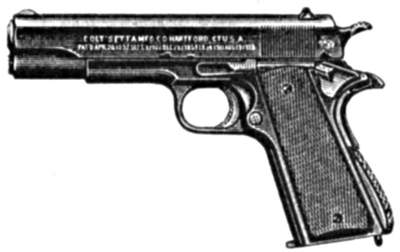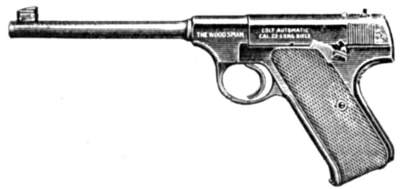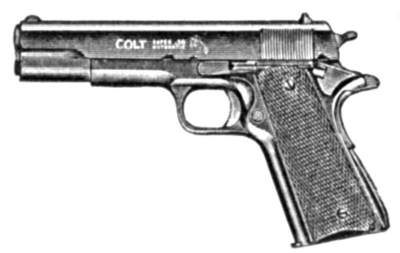The following information on the .45 automatic pistol comes from Section 17 of Shooting by J. Henry FitzGerald. Shooting is also available to purchase in print.
While the revolver and single shot pistols are very popular with both police and target shooters the automatic pistols are a very close second, and if we may judge by Camp Perry enthusiasts the .45 Colt Government model and the .22 Colt automatic are the peers of all hand guns. You will see the .45 in matches against the finest of target revolvers and the .22 automatic winning against the single shot pistols. This is not an occasional happening, but a regular thing which eliminates all chance of accidental high scores.
In 1919 at Caldwell, New Jersey, the .45 automatic came into its own. In the earlier years of its existence the comments and criticisms were these: sights not being attached to the barrel, short distance between sights, slide loose on receiver, trigger pull not right, etc. These all retarded its popularity, but only for a short time. A few shots from a properly sighted .45 automatic will convince the most skeptical that it is a wonderful arm and very accurate, extremely so if fitted with the .45 Colt Match Barrel. These barrels were first used in 1919 and after months of experimenting at the Colt factory. I took forty of these match barrels to the National Shoot that year and the records made at this shoot convinced the most doubting that the .45 automatic equaled any of the large caliber side arms in existence.
As to the sights not being attached to the barrel, the scores made from year to year are all I need mention to disprove this claim, but I will further state that the barrel and slide comes back to the same position each time. The function of the gun is the same, provided the ammunition is of even pressure and the bullets of normal size. A slide which is slightly loose on the receiver does not mean that the arm is not accurate. It is more accurate than a slide which is too tight to work freely. It comes back to the same place in the same way every time. The trigger pull is very easily remedied; government requirements call for a six to seven and one-half pound pull, but at Camp Perry a pull of four pounds or over may be used. This means a change in every arm used and I believe that a four and one-half pound pull will suit nearly all the shooters. It is very easy to make this change if the parts have not been put through the third degree by some enterprising soul. My advice to shooters is this: Unless you know the duty performed by each part and why it is there, do not try to adjust the arm yourself; send it to the factory.
The sear should never be worked on, the hammer only should be changed, and the angle of the notch on this should never be changed. I do not believe in a stone and use only a fine file for the work, allowing the parts to smooth themselves as they slide over each other. An automatic is different from the revolver in regard to pull. The revolver hammer is drawn back by hand with very little jar, while the automatic hammer is carried backward at the same speed as the slide and must also resist the jar of the slide as it reaches its forward position.
A great many times I adjust a trigger pull and some time afterward the same arm is brought to me with the complaint that the pull did not stand up and that the hammer follows or falls to a half-cocked position. Usually this is caused by cocking and snapping the empty pistol and sometimes by putting the thumb of the other hand behind the hammer as the trigger is pulled. If this sport is indulged in for a short time the hammer will follow as the slide closes.
The correct way to try out the .45 automatic after the trigger pull has been corrected is to fire twenty-five or fifty shots through it. In this way the edge of the sear will fall into the bottom of the hammer notch and will make its own seat as the arm is fired. The sear must fall into the notch and not on the middle of a smooth surface or a creep will be the result. The weight of the pull must be the force required to pull the sear out of the notch and the sear must come clean without sliding on the top of the notch. In other words, the force required to start the sear must throw it over the top of the notch, therefore, when the hammer is drawn back slowly without the forward action and jar of the slide the sear is not properly seating itself in the notch. After a little use on the firing line the arm may be used for dry shooting with little if any damage to the pull and when a revolver or automatic pistol is working properly my advice is to shoot it and to try to improve yourself instead of the gun.

One point in favor of the .45 automatic is that you may have an old, much abused arm that has been through the war, with a rusted barrel and other troubles, but clean it up, fit a match barrel, correct the pull, fit the modern sights which cannot be jarred loose by firing, and you have a fine target arm at a small expense for overhauling. It is not necessary to have the arm re-blued as this does not improve the shooting. The heart of the .45 automatic is the barrel. With a good barrel you can correct everything else on the pistol, but without a good barrel you will never be satisfied with your scores. I have never seen a .45 automatic that would not shoot if properly corrected.
That echo of war days “They jam” is due more to the carelessness of the owner than it is to any fault with the pistol. It is true that the care and time spent on the war-time pistols cannot be compared to the exacting methods employed on the present-day .45 automatics, but even the war-time product in the hands of a man who knew how to use it gave very little trouble. A rusty chamber would cause a jam then and it will today in the very latest pistol which has been allowed to become rusty. I remember an instance in 1920 when a pistol was shown to me by a veteran of the World War and he told me that he been over the top eight times and that he had never seen a .45 automatic that did not jam. I loaned him mine to try and after seven shots he handed it back and told me the gun was like all the rest. I discovered the trouble was that the slide remained open after the last shot as it should do in all well-behaved .45 Government automatics. When I told him my deductions he told me that he had never heard of such a thing. Trouble is bound to develop where any man is handed a machine of any kind that he does not understand. Very little trouble is encountered from the .45 automatic if the owner has a working knowledge of the arm and keeps the barrel and chamber clean.

And now the .45 automatic’s little brother, the .22 Colt automatic. Due to the fact that the bullet is seated in the barrel the .22 automatic is more accurate than any .22 caliber revolver. It is rifled for the two hundred yard ammunition, one twist in fourteen inches, a special chamber with the bullet resting on the lands in the barrel, which is the last word in .22 caliber accuracy.
Due to the shape and hang of the automatic pistols, to get the best work out of them stick to them and do very little work with the revolvers. This same rule applies to revolvers when working to perfect yourself with them. Both are very different and require careful study. I have seen expert revolver men pick up the .45 automatic on the day of the big match or a few days before and try to accustom themselves to it but that seldom works out satisfactorily.
This section is not written with the hope of turning some man who loves revolvers toward automatics. But in case he should enter a match in which either the .22 or .45 automatic pistol is also shot and he comes out second best, he should not feel that he has been beaten by an inferior arm in the hands of a far better shot; he has been beaten by a slightly better man with an arm that is just as accurate as his favorite revolver.

While on the subject of automatic pistols we must not forget the recent addition to the automatic family, the .38 Super Colt. This model is worthy of the consideration of every one interested in small arms shooting. It equals the .45 automatic as to accuracy at twenty-five or fifty yards and surpasses it in accuracy at the longer ranges. I believe that many who are annoyed by the heavy recoil of the .45 automatic will be pleasantly surprised with lighter recoil of the .38 Super Colt. At the same time it delivers a heavier blow than the larger caliber arm and at a greater distance. Due to the sturdy construction of this arm and modern .38 automatic ammunition, this pistol is in a class by itself for hunting or target shooting and answers every requirement.
